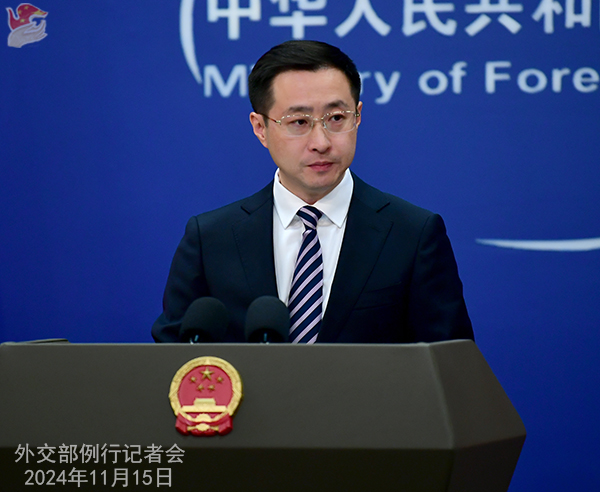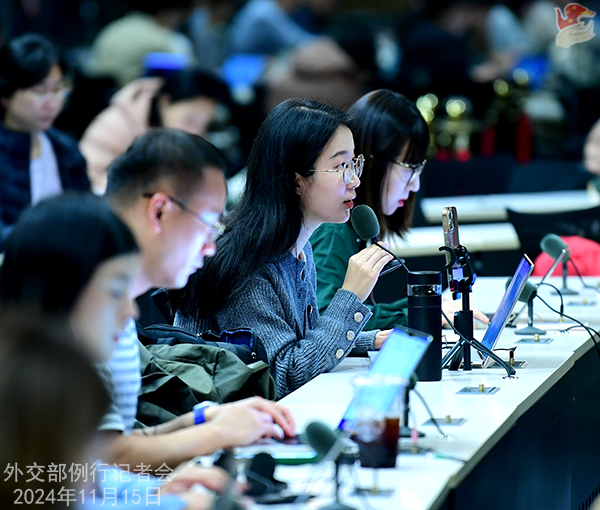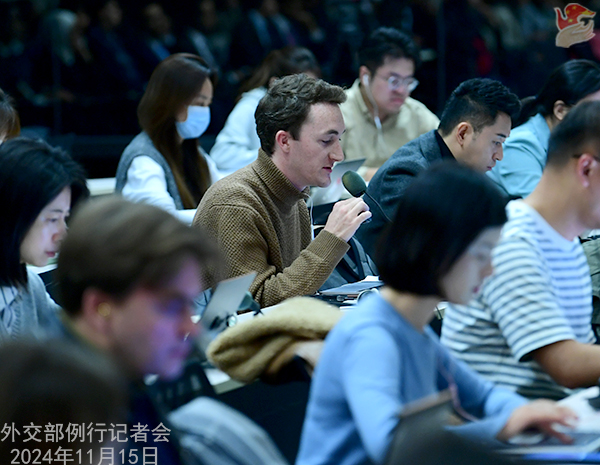
CCTV: On November 14 local time, President Xi Jinping arrived in Lima by special plane to attend the 31st APEC Economic Leaders’ Meeting and pay a state visit to Peru. Can you share more information with us?
Lin Jian: On the afternoon of November 14 local time, President Xi Jinping held talks with President Dina Boluarte to have in-depth exchange of views on bilateral ties, cooperation in priority areas and other issues. The two heads of state jointly witnessed the signing of a Belt and Road cooperation plan, and the Optimization Protocol of the Free Trade Agreement Between China and Peru. The two sides issued a joint declaration on deepening the comprehensive strategic partnership. The two heads of state also attended the inauguration ceremony of Chancay Port via video link.
President Xi Jinping noted that both China and Peru are ancient civilizations. Following the principle of equality, mutual respect, mutual trust and mutual learning, China-Peru ties have become a model of solidarity and cooperation among countries of different sizes, systems, and cultures. Since the establishment of diplomatic ties 53 years ago, trade and investment cooperation between China and Peru have grown rapidly, bringing tangible benefits to the two peoples. The two sides need to synergize development strategies, tap cooperation potential, create a new pattern of practical cooperation, boost the driving force of the two wheels of trade and investment, advance the development of both traditional and emerging industries, and promote the integration of the industrial and supply chains. The two sides should strengthen exchanges of governance experience, shoulder the responsibility of mutual learning among civilizations as required by our times, and carry forward China-Peru friendship from generation to generation. Both China and Peru stand for multilateralism and oppose protectionism. China firmly supports Peru’s presidency of APEC and will work for the success of this APEC Economic Leaders’ Meeting. China stands ready to strengthen communication and cooperation with Peru under the framework of the China-CELAC Forum and make positive contributions to the development of the relations between China and Latin America and the Caribbean.
This is President Xi Jinping’s second state visit to Peru and also the third meeting between the two heads of state within this year. It bears historical significance and is highly relevant to our times. China stands ready to work with Peru, following the important common understandings between the two presidents, to further consolidate political mutual trust, upgrade practical cooperation, and bring the China-Peru comprehensive strategic partnership to a new level for the benefit of the peoples of two countries.
Reuters: Taiwan’s Lai Ching-te is planning to stop in Hawaii and maybe Guam on a visit overseas in the coming weeks, sources told Reuters. Would the Foreign Ministry like to comment on that?
Lin Jian: The one-China principle is a prevailing international consensus. The Taiwan authorities’ political manipulation activities and separatist provocations using countries having so-called “diplomatic ties” with Taiwan will lead nowhere. It will not shake the solid and strong international commitment to the one-China principle, or stop the overriding historical trend towards China’s reunification. On the so-called “transit” in the US by leader of the Taiwan region, we always firmly oppose the US’s arrangement for such kind of “transit” trip. We urge the US to abide by the one-China principle and provisions in the three China-US joint communiqués, not to allow Lai Ching-te to “transit,” not to send any wrong signal to “Taiwan independence” forces, and take concrete actions to uphold China-US relations and peace and stability across the Taiwan Strait.
Xinhua News Agency: We noted that the presidents of China and Peru bore witness to the inauguration ceremony of Chancay Port. After the inauguration, the port is expected to become an important shipping hub in Latin America and a gateway to the Pacific Ocean, and greatly reduce the direct shipping time from Peru to Asia. Could you share more details?
Lin Jian: On November 14 local time, President Xi Jinping and President Boluarte in Lima attended via video the inauguration ceremony of Chancay Port.
As President Xi Jinping stressed, Chancay Port is not only an important project under Belt and Road cooperation, but also the first smart and green port in South America. The first phase of the project, when completed, will reduce the sea shipping time from Peru to China to 23 days, thus cutting logistics costs by at least 20 percent. It is expected to generate US$4.5 billion in yearly revenues for Peru and create over 8,000 direct jobs. The completion of Chancay Port will effectively consolidate Peru’s role as a gateway linking shipping routes across land and sea, and between Asia and Latin America, and boost the overall development and integration of Latin America and the Caribbean. The port’s development plan also includes establishing animal rescue services to improve the environment of wetlands, beaches, and habitats, and contribute to sustainable development of the local economy and society.
Chancay Port is becoming a starting point of an Inca Trail of the New Era. From Chancay to Shanghai, it is witnessing the coming into shape of a new route across land and ocean between Asia and LAC in the new era. China will follow the guidance of the common understandings between the two presidents, uphold the principle of extensive consultation, joint contribution and shared benefit, and work with Peru to ensure the success of Chancay Port from construction through management and operation, so that it will empower the common development of Pacific’s coastal economies, including China and Peru, and truly contribute to prosperity and happiness for Peru and all other LAC countries.

China News Service: We noted that statistics released by competent authorities yesterday show that China saw its annual output of new energy vehicles exceed 10 million for the first time, becoming the first country in the world to make this achievement. Foreign media commented that this represents China’s effort for green energy transition. What’s your comment?
Lin Jian: We noted relevant report. I’d refer you to competent authorities for anything specific. Let me stress that with 90 percent of the vehicles purchased by domestic consumers, the fast growth of China’s new energy vehicle industry highlights the potential of China’s mega-sized market. It also demonstrates the firm resolve of the Chinese government to advance green and low-carbon development and contribute to global carbon neutrality. According to the statistics of the International Energy Agency, to realize carbon neutrality, total global EV sales will need to reach 45 million in 2030. China will continue to promote high-quality development and high-standard opening up, deepen cooperation in the industrial and supply chains of new energy, advance tech innovation and the development of relevant sector to offer the world more high-quality green products and better turbocharge global green development.
As Ding Xuexiang, President Xi Jinping’s Special Representative and Vice Premier of the State Council, said at the World Leaders Climate Action Summit of the 29th Conference of the Parties to the UN Framework Convention on Climate Change, the key to solve climate change is the radical transformation of growth models. The international community needs to work together to speed up energy transition in a fair, orderly and just way, keep industrial and supply chains of the new energy industry stable, promote the accessibility and innovation of green products and technologies, accelerate the cultivation of new quality productive forces, foster a free and fair international environment for green and low-carbon investment, trade and technology cooperation, and boost global green and low-carbon transition.
AFP: Brian Nichols, the US Assistant Secretary of State for Western Hemisphere Affairs, said yesterday that it is essential that LAC countries ensure that “PRC economic activities respect local laws as well as safeguard human rights and environmental protections.” What’s China’s response?
Lin Jian: China is committed to growing friendship and cooperative ties with LAC countries under the principle of mutual respect, equality, mutual benefit, openness, inclusiveness and win-win cooperation. We never attach any strings, or target any third party, and we have no intention to compete with any country for influence. LAC countries, as independent sovereign states, have the right and the capability of independently choosing development path and cooperation partner. China-LAC cooperation has brought tangible benefit to socioeconomic development of regional countries and has been widely welcomed and recognized by regional countries. The Chancay Port that I mentioned is such a case in point.
China Daily: Today marks the fourth anniversary of the signing of the Regional Comprehensive Economic Partnership Agreement (RCEP). Can you update us on what it has achieved and China’s role in it?
Lin Jian: RCEP covers more population and involves more trade than any other free trade agreement in today’s world. Since its official implementation, RCEP has been delivering institutional benefits, such as easing tariffs, streamlining customs clearance, and facilitating trade and investment. It has made regional industrial and supply chains more stable and unimpeded and opened up a new phase of high-quality development of regional economy.
As the largest economy among RCEP members, China is an active promoter of high-quality implementation of the agreement. In the first three quarters of this year, imports and exports between China and other RCEP members totaled RMB9.63 trillion, up by 4.5 percent year-on-year. In 2023, non-financial direct investment from China to other RCEP members reached US$18.06 billion, up by 26 percent year-on-year, which is 14 percentage points higher than the growth rate of China’s investment globally. As this year’s non-ASEAN rotating chair of RCEP, China has played a leading role in high-standard compliance with RCEP and made great contribution to enhancing the overall implementation of RCEP in the region. We will stay committed to advancing comprehensive and high-quality implementation of RCEP, injecting more impetus into regional trade growth and economic integration, and bringing more tangible benefits to the people in the Asia-Pacific.
